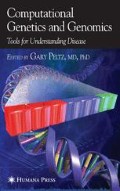Abstract
Variability may be introduced in an observed phenotype by a range of elements. Inherited genetic factors, as well as environmental and behavioral conditions, may affect the phenotype. The blend of all these interactions gives rise to the unique being every living creature is. Experimental genetics has traditionally been, and still is, a very powerful tool for dissecting the genetic factors out of the blend that results in the observed phenotype complexity.
Access this chapter
Tax calculation will be finalised at checkout
Purchases are for personal use only
Preview
Unable to display preview. Download preview PDF.
References
Cormier RT, Hong KH, Halberg RB, et al. Secretory phospholipase Pla2g2a confers resistance to intestinal tumorigenesis. Nat Genet 1997;17:88–91.
Darvasi A. Experimental strategies for the genetic dissection of complex traits in animal models. Nat Genet 1998;18:19–23.
Darvasi A, Soller M. Advanced intercross lines, an experimental population for fine genetic mapping. Genetics 1995;141:943–951.
Dietrich W, Katz H, Lincoln SE, et al. A genetic map of the mouse suitable for typing intraspecific crosses. Genetics 1992;131:423–447.
Dupuis J, Siegmund D. Statistical methods for mapping quantitative trait loci from a dense set of markers. Genetics 1999;151:373–386.
Eppig JT, Nadeau JH. Comparative maps: the mammalian jigsaw puzzle. Curr Opin Genet Dev 1995;5: 709–716.
Frary A, Nesbitt TC, Grandillo S, et al. fw2.2: a quantitative trait locus key to the evolution of tomato fruit size. Science 2000;289:85–88.
Haldane JBS, Waddington CH. Inbreeding and linkage. Genetics 1931;16:357–374.
Kimura M. A probability method for treating inbreeding systems, especially with linked genes. Biometrics 1963;19:1–17.
Korol AB, Ronin YI, Kirzhner VM. Interval mapping of quantitative trait loci employing correlated trait complexes. Genetics 1995;140:1137–1147.
Lander ES, Botstein D. Mapping Mendelian factors underlying quantitative traits using RFLP linkage maps [published erratum appears in Genetics 1994;136:705]. Genetics 1989;121:185–199.
Manly KF, Olson JM. Overview of QTL mapping software and introduction to map manager QT. Mamm Genome 1999;10:327–334.
Moore KJ, Nagle DL. Complex trait analysis in the mouse: the strengths, the limitations and the promise yet to come. Annu Rev Genet 2000;34:653–686.
Morse HC, III. The laboratory mouse: a historical perspective. In: Foster HL, Small JD, Fox JG, eds. The mouse in biomedical research. vol. 1. History, genetics, and wildmice. New York: Academic, 1981.
O’Brien SJ, Menotti-Raymond M, Murphy WJ, et al. The promise of comparative genomics in mammals. Science 1999;286:458–462, 479–481.
Siegmund D. Sequential analysis: tests and confidence intervals. New York: Springer, 1985.
Silver LM. Mouse genetics: concepts and applications. New York, Oxford: Oxford University Press, 1995. http://www.princeton.edu/lsilver/book/MGcontents.html.
Steinmetz LM, Sinha H, Richards DR, et al. Dissecting the architecture of a quantitative trait locus in yeast. Nature 2002;416:326–330.
Author information
Authors and Affiliations
Editor information
Editors and Affiliations
Rights and permissions
Copyright information
© 2005 Humana Press Inc., Totowa, NJ
About this chapter
Cite this chapter
Yakir, B., Pisanté, A., Darvasi, A. (2005). Statistical Theory in QTL Mapping. In: Peltz, G. (eds) Computational Genetics and Genomics. Humana Press. https://doi.org/10.1007/978-1-59259-930-1_2
Download citation
DOI: https://doi.org/10.1007/978-1-59259-930-1_2
Publisher Name: Humana Press
Print ISBN: 978-1-58829-187-5
Online ISBN: 978-1-59259-930-1
eBook Packages: Biomedical and Life SciencesBiomedical and Life Sciences (R0)

